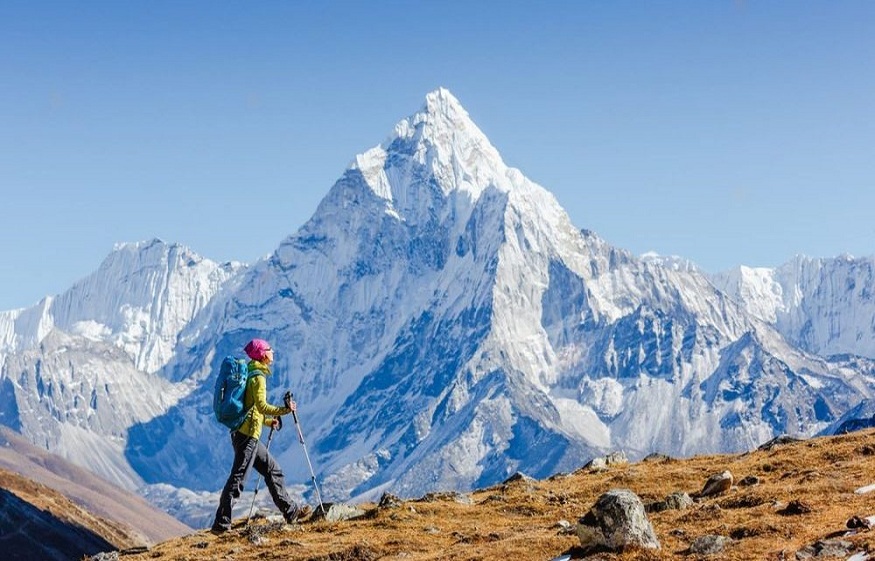
Food & Water Safety on the Everest Base Camp Trek
Food and water safety are also important considerations when planning your Everest Base Camp (EBC) trek. When trekking in the remote Khumbu region of Nepal, where resources are scarce, you should be cautious to avoid foodborne illnesses and dehydration, particularly as you are trekking at high altitudes. The hike may be difficult, but keeping your energy up and staying hydrated is essential during your journey to your destination, and in turn helps make the trek easier and more pleasant.
Food on the Everest Base Camp Trek Cost. There are tea houses along the Everest Base Camp trek route that serve a wide variety of meals catering to the trekking needs of trekkers. Most tea houses do serve healthy food, but food hygiene standards may not be as high as those in more developed areas. Consequently, there is a greater risk of foodborne illnesses like diarrhea or stomach cramps from contaminated food or water.
Traditional meals in the region, such as dal bhat (lentil soup with rice), momo (dumplings), noodles, and fried rice, should be safe if they are adequately cooked. When dining in tea houses or lodges, you should aim for hot, freshly prepared meals and avoid salad or raw food, which may not have been prepared with purified water. “Vegetarian meal” is, by and large, a safer bet.
Hydration is paramount on any successful trek, and especially at altitude. But drinking unfiltered water can make you susceptible to waterborne diseases such as Giardia or E. coli. Tap water on the trek is usually untreated, so it is unsafe to drink directly from rivers or streams.
Bring your water purification system for water safety. Then use water purification tablets, filters, or boiled water. If the trek goes higher, you need to be even more careful about the water you drink, so many tea houses offer boiled water for trekkers to purchase, but be sure to ask if it was boiled long enough. It’s also smart to bring a water bottle that you can replenish on the route, as single-use plastic bottles are a source of environmental pollution in the area.
If you do purchase bottled water on the trek, keep in mind that single-use plastic bottles are a major source of environmental pollution. In the Everest region, many tea houses will provide purified water for a small charge. Using a reusable water bottle with a filter or purification system is more environmentally friendly and reduces plastic waste. Some trekkers use UV sterilizers or filter pumps to purify water as they go.
When hiking in high altitudes, you’re also losing more water through sweat and respiration, so it’s crucial to drink constantly even if you don’t feel thirsty. The drier climate of higher altitudes demands more fluid intake for your body to stay properly hydration.
When possible, eat hot, cooked food, which helps minimize the risk of contamination.
Water from streams or rivers must always be distilled through purification tablets, filters, or boiling.
Most tea houses have boiled water; make sure to drink boiled water over 20 minutes.
Bring a reusable water bottle and a purification system to easily stock up on safe water and cut down on plastic waste.
Steer clear of raw vegetables or unpeeled fruits unless you can confirm that they’ve been washed in safe water.
If in doubt about the cleanliness of the food, select vegetarian dishes and ask for simple meals that are less likely to require long preparation and are more likely to be fully cooked.
Pack food items to bring as reserve food (e.g., energy bars, nuts, or dried fruit), especially for longer days or those with limited food resources.
Trek to Base Camp Mount Everest With proper planning, quality food and water hygiene, and appropriate awareness of the potential risks, you can drastically minimize your chances of getting sick and spend an amazing and safe trek of a lifetime reaching the Kalapathar or Everest Base Camp. One of the most important parts of your planning — aside from the actual trekking and lodging info — will be food and water safety to help you avoid unnecessary illnesses that could risk your ability to finish the hike. 1 Comment: Stay hydrated, eat wisely, and enjoy the journey to one of the most iconic destinations in the world.
Introduction to Food & Water Safety on Trek
The area is remote, and the infrastructure at times basic, so trekkers must be especially careful about hydration and nourishment. Contaminated drinking water and badly cooked food can get you sick and derail your trek. Tea houses along the way provide food and water, but they often don’t rise to the hygiene standards that many trekkers are used to. Knowing how to source and prepare your food and water safely will help ensure you have a safe and enjoyable experience. On the trek, you should always expect uncomfortable weather, heat, cold, wind, or whatever, so maintaining proper hydration and eating foods that will keep your energy levels high will be crucial on this trek. If you follow proper safety precautions and have an understanding of possible hazards, you can minimize health risks and ensure that your trek is seamless.
The Food and Water Challenge on the Trail
The major challenge with food and water on the Everest Base Camp trek is the standard of hygiene at high altitude. Water sources along the route are often untreated, and food might not be prepared in a way that guarantees cleanliness. On a related note, hiking at high altitudes can cause you to become more dehydrated, which means that it’s crucial to manage your water supply! The dry air at higher elevations can also dehydrate you quicker than usual, as your body requires more moisture as you go up. This, along with limited access to resources, means you must budget your food and water intake. Given the risks of stomach-related illnesses from tainted food or water, making sure you have access to safe drinking water as well as fresh, well-prepared food is of utmost importance. In addition, trekking often means we need more calories, or at least more nutrient-dense foods, and that is not always present in the remote tea houses. By being careful and well-planned, you can overcome these hurdles and enjoy a wonderful trek.
PROTECT YOURSELF WITH PURIFIED WATER
One of the biggest concerns on the Everest Base Camp trek is water safety. Although there are natural water sources, including rivers and streams, in the area, these are not always safe for drinking and often require a purification process. Many tea houses will charge trekkers a small fee to provide boiled water, which is the safest bet if it is available. But it is always important that you confirm the water is boiled for a sufficient period, because the higher the altitude, the longer the boiling time is required to kill bacteria and parasites effectively. Most tea houses and lodges also sell bottled water, but this is expensive and harmful to the environment. When fetching water from natural sources, use a reliable means of filtering or purifying. Note that water at high altitude may carry more risk from contamination from animal waste or human activity in remote areas. Accessible drinking water can act as a health risk, as well, so to avoid it, plan accordingly; for instance, bring a water bottle with a filter or purification tablets to treat water from streams and rivers before drinking.
How To Purify Water: Boiling, Filters, and Tablets
While Everest Base Camp Trek, there are some different methods of purifying water, and you must use one of these so that you do not consume contaminated water. The most popular and safe way is boiling. At higher altitudes, boiling water for 3–5 minutes can kill harmful bacteria and parasites. Several trekkers utilize water filters, portable devices for the physical removal of contaminants from water. Filters are user-friendly and don’t need to be boiled, though some models may be slower or less effective at altitude. To make it easier, some hikers bring purification tablets or drops, which neutralize harmful microorganisms in water. These are lightweight, portable, and a pretty good backup choice, but they may taste terrible. Each method has its pros and cons, so it’s important to decide which one works best for you. Boiling water for safety and filters/tablets for convenience is common for many trekkers, so they can always have safe drinking water wherever they are on the trek.
What to Know About Food Supply Availability
The availability of food on the Everest Base Camp trek is vastly different based on the area and altitude. You’ll find tea houses along the hike to rest and eat. The tea houses usually have a limited but wholesome menu, catering to the needs of trekkers. Food is limited to dal bhat (lentil soup with rice), noodles, fried rice, and momos (dumplings). As you go higher, the variety of foods decreases, and meals become simpler and more expensive due to logistical difficulties at greater altitude. Although food is available in most of the stops along the trail, it’s not always freshly prepared or up to what would be considered hygiene standards in the West, so people should choose foods that are cooked well. Higher altitude regions may offer more limited dining options, and so carrying along snacks is advisable, including energy bars, dried fruits, or nuts to supplement your meals. While these factors may present challenges, with proper planning, you can eat healthy and have energy all along the trek.
Traditional Cuisine of the Himalayan Regions
Food on the Everest Base Camp trek is native to Nepali and Sherpa culture. The most common dish is dal bhat, a filling dish of lentil soup and rice. This dish is nutritious and filling, giving trekkers what they need to power long days of hiking. Momos (steamed or fried dumplings filled with vegetables or meat) are another popular snack, typically served with spicy chutney, in addition to dal bhat. Sherpa stew and thukpa (noodle soup) are also common and warming options, particularly helpful when you’re at higher altitudes, where the chill in the air can make you feel hungrier. The food is predominantly vegetarian, though chicken and yak can be found in some places. People drink Chiya (Nepali tea) a lot, mostly during the mornings, to warm up. Though the food is basic, it’s aimed at providing the calories and nutrients needed to keep trekkers going on the long path ahead. Note that the food quality can vary, so to avoid foodborne diseases, please stick to well-cooked food (very important).
Stay Safe: Tips for Preventing Stomach Problems
Everest Base Camp Treks is one of the most popular adventures, but one of the most fretted about dangers is stomach problems from contaminated food or water. The altitude, the new weather conditions, and the various ways of preparing food can trigger digestive problems: diarrhea, nausea, or food poisoning. It is very important to be careful about what you eat and drink during this trek to reduce the chance of getting stomach problems. You make sure to eat cooked food over raw or uncooked items that harbor harmful bacteria, as heat kills bacteria. Drink only boiled water from good tea houses and do not drink water from natural sources unless you’ve boiled and filtered it yourself. Hand hygiene is essential — always wash your hands thoroughly with soap and clean water before eating or handling food, and have hand sanitizer ready for situations when water is not available. Pack wet wipes to cleanse your hands before eating. Also, avoid dairy products that are not pasteurized, as they could make you feel sick. If in doubt, play it safe with really simple dishes like noodles or rice, which are less likely to cause any problems. By practicing food and water safety, you can prevent picking up stomach dramas, so you can focus on enjoying the trek!
Food Contamination and Hygiene Management
As tea houses and remote lodges have less of a focus on hygiene, one of the significant threats to disease is food contamination on the Everest Base Camp trek. The high-altitude setting also means that food preparation likely won’t be at the level of hygiene you are used to in your home country. To avoid the risk of contamination, always make sure that the food you eat is well-cooked, because the heat kills many of the bad bacteria and viruses. Raw vegetables, unpeeled fruits, and uncooked salads should be avoided because they may have been washed in contaminated water, she said. Fish can also be a hazard, so if you decide to eat fish, make sure it’s freshly cooked. Try to eat vegetarian whenever you can, as they are usually safer and less likely to go bad. Be careful with food handling, too. Pay attention to how the staff handles your meal — if it looks unsanitary, or food isn’t being cooked correctly, opt for something else. Always boil or purify drinking water; don’t drink from streams or untreated sources. It is advisable to carry water purification tablets or a filter. Adhering to these practices may significantly reduce the risk of foodborne illness while trekking in the Himalayas.
Tips for Staying Hydrated at Altitude
Mount Everest Base Camp Trek Hydration: It is one of the fundamental keys to a healthy ascent in the Everest Base Camp trek, mainly in higher altitudes. As you climb higher, the air gets drier and the altitude rises, making you lose moisture through sweating and breathing even if you’re not feeling thirsty. Dehydration can worsen altitude sickness, so it’s essential to drink enough water during the day. Try to drink 3–4 liters of water each day to remain properly hydrated. Always have water purification tablets or a filter on hand to be sure that the water you are drinking is safe. The water from streams or lakes can have harmful microorganisms and should not be consumed without treatment. There are several ways to stay hydrated, including electrolyte drinks or electrolyte tablets that can be dissolved in water to help replace essential minerals such as sodium, potassium, and magnesium, which are lost at altitude. When hiking, sip steadily rather than waiting to feel thirsty, since thirst isn’t always a reliable indicator at altitude. You should also stay away from caffeinated drinks, as they can also lead to dehydration. Finally, monitor your urinary color — it should be pale yellow; darker urine may indicate dehydration. So, stay properly hydrated and you will have more energy, acclimate more easily, and lessen the risks of altitude sickness.
What You Will Need for Emergency Food and Water
As you hike to Everest Base Camp, always have emergency food and hydration supplies, as availability is often sparse along the trail, and the weather can be unpredictable at times. Emergency food should be high-energy, lightweight weight and non-perishable. You might pack energy bars, trail mix, nuts, dried fruits, or instant oatmeal, all convenient, high-calorie, high-density foods. These foods give rapid energy boosts and don’t occupy too much room in your pack. Bring enough emergency food to cover several days, just in case of delays or other unforeseen events. As far as getting water goes, a lot of your water purification systems work; you can filter your water, you can use a UV purifier like a lifesaver, or purification tablets, so that you never have an issue with finally being able to have drinking water. You should also bring a hydration bladder or water bottle with a filter so you can refill from water sources along your trail. You’ll also need a lightweight cooking stove and fuel, though if you intend to prepare meals, you’ll also need freeze-dried meals that cook with just hot water, in addition to food and water. This is why keeping essential items for an emergency handy allows you to cope with unforeseen circumstances while ensuring your health and safety while trekking.
What food is eaten during the Everest Base Camp trek?
In general, meals on the Everest Base Camp trek are simple, high-energy foods that can be prepared quickly in the relative isolation of the high Himalayas. Food is typically traditional Nepali or Sherpa fare. The most common is dal bhat (lentil soup with rice), a hearty, healthy meal giving a constant energy supply. Some other popular meals are momo (dumplings stuffed with vegetables or meat), thukpa (noodle soup), and fried rice or noodles. Vegetarian food is one of the safest types of food you can get, especially at high altitude after reaching your destination, where they cannot refrigerate food from meat or animal sources. On the trail, you’ll find snacks like biscuits, energy bars, chocolate, and dried fruit for a quick hit of energy. In the higher parts of the trek, food is limited and more costly, but typically plenty of simple meals to prop you up. Tea (often black tea or chai) is a common beverage, a source of warmth when temperatures drop , and a source of hydration.
What precautions should you take while going to Everest Base Camp?
When climbing to Everest Base Camp, you need to be in safe hands, for both safety and health! First and foremost, you should know the risk of altitude sickness. To avoid it, climb slowly, give yourself plenty of time to acclimatize, and avoid overexertion. And stay hydrated; consume boiled or purified water in large quantities to keep waterborne diseases at bay. Food hygiene is another issue, so always go for well-cooked meals, avoid raw vegetables or unpeeled fruits, and be careful with meat. It’s also a good idea to carry your water purification tablets or filter to make sure the water is safe to drink. Physical preparation is essential — train your body to undertake long hikes with a weighted backpack and do cardio before you get there. So pack clothing for different temperatures; the weather can shift quickly. Make sure you have the required trekking permits and remember to adhere to the guidelines regarding safety and local customs. And it’s also helpful to have first-aid supplies, such as medications for altitude sickness or stomach ailments, and common essentials like sunscreen and lip balm to protect against sun exposure at high altitudes.
How much is food on the Everest Base Camp trek?
Food costs on the Himalayan Base Camp Trek at various points along the route, including the altitude. And as you go up, food prices typically climb due to cost and logistical issues with transporting goods. For a low altitude (eg, Lukla, Phakding, Namche Bazaar) average meal, you should expect to invest approximately $5–USD 10. But once you go beyond Base Camp, especially in more remote regions, meals can run anywhere from $10 to USD 20. Simple fare, like dal bhat (lentil soup and rice), is generally inexpensive, while Western dishes or meat-based meals can range into higher prices. Realize that the price is higher in places like Tengboche and Dingboche than in lower altitude areas. As a way of cutting down on costs, it’s generally suggested to order staple local meals such as vegetarian meals or noodles, since those tend to be cheaper while still being nutritious. Also, note that some tea houses will charge you if you drink water, especially bottled water, so boil your own or use a filter, and you can save on costs!
What food do you bring to Mount Everest?
As you hike to Everest Base Camps, bringing your emergency food is a wise decision, especially if there are any delays or limited food options in isolated areas. All the essentials that you need at sea, such as light, non-perishable, and high-energy foods. Among the most popular ones are energy bars, dried fruits, nuts, trail mix, and granola bars. They’re easy to transport, don’t take up much room, and can provide a quick burst of energy during your trek. Simply putting the options together is a case of making a meal out of your trail food: If you plan to cook on the trail, you may want instant oatmeal, freeze-dried meals, or instant noodles. These meals are lightweight, boil-in-the-bag meals made with just water and will keep you well-nourished on those long backcountry days. If you’re traveling in off-peak season or want the assurance of food availability, think about bringing extra snacks, protein powder, or even dehydrated meals. Skip overly bulky food items and allow yourself to stock up on a few more compact, energy-dense options to get you through the trek. Always carry enough food for at least a few days and sometimes even weeks for the more remote areas.


